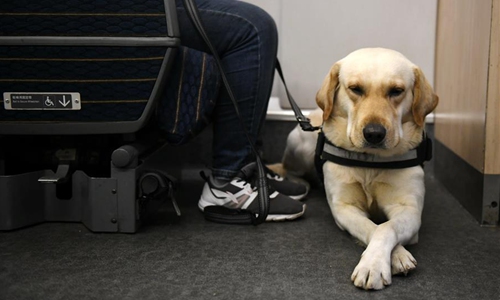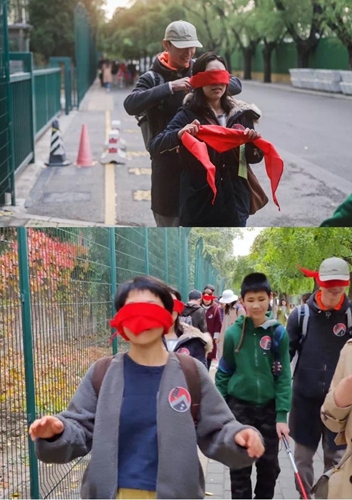Chinese netizens call for more support for the visually impaired after guide dog not allowed on a bus

A guide dog takes a train in northwest China's Shaanxi Province, Jan. 12, 2020. Guide dogs are trained to adapt to taking bullet trains in order to help visually impaired passengers navigate during the Spring Festival travel rush. Photo: Xinhua
A video showing a traffic police officer pretending to be blind being denied permission to get on a bus with a guide dog has been drawing public attention and has led to heated online discussions about the lack of support and care for the visually impaired.
The video was taken in Taiyuan, capital city of North China's Shanxi Province. The traffic officer wanted to draw public attention to difficulties faced by visually impaired people with the video.
Guide dog in distress
As shown in the video, wearing a gauze blindfold, the officer wasn't allowed on the bus with the guide dog, and was told no dogs are allowed whether they're guide dogs or not. Some passengers also scolded the officer for making a scene and wasting their time, while the dog appeared very distressed.
The guide dog's owner Gao Zhipeng, who is visually impaired, told media Monday that this has been happening almost every day since he brought Taobao home in 2014, and it is the same when catching a cab. And each time they were refused, Taobao would sink into depression for days.
The related hashtags had attracted 740 million views and nearly 300,000 posts on China's Twitter-like Sina Weibo as of Tuesday evening. Many netizens have called for enhanced public understanding of guide dogs and want to raise awareness about travel difficulties faced by visually impaired people. Some shared posts with the hashtag "I accept guide dogs" to show support and express their willingness to share a ride with the dog and its owner.
"There are more than 17 million visually impaired persons in China, but only a little over 200 guide dogs. That's even fewer than giant pandas. They all want a guide dog, but the application takes forever," said Guan Li, founder of Home of Sunshine Guide Dog Center in Central China's Henan Province, in an interview with Donggua Video back in May 2019.

Participants in the “See the invisible” walk wear blindfolds while walking along tactile paving in Beijing on November 3, 2019. Photo: Courtesy of Sustainable Cities & Mobility
Tip of iceberg
The guide dog being denied boarding is just the tip of the iceberg, compared to the various difficulties faced by the country's visually impaired population every day when they leave their home.
"It happened to me and a lot of my friends [who are blind or visually impaired]. When we show our proof of Grade One Blindness, which should allow us to take the bus for free, sometimes the drivers insist on us paying without even looking at our cards. When you call the company to file a complaint, they always find excuses and shift responsibilities around," Cao Shengkang told the Global Times Tuesday.
Cao perhaps is the best-known visually impaired backpacker in China, who has traveled alone to 34 countries on five continents. His story was shared through a 2018 documentary In My Eyes.
He took part in a walk called "See the invisible" in November 2019 with several visually impaired children around the embassy areas in Beijing. The walk was hosted by Sustainable Cities & Mobility, an organization consisting of 430 volunteers dedicated to improving sustainable development of cities in China, aiming to determine if tactile paving (which is called blind lanes in Chinese) can help the blind and visually impaired navigate the city.
It turned out that they were not reliable as there were some bumps that a non-visually impaired person could easily trip over and some sections of the tactile paving were blocked by objects such as utility poles.
"We picked a route that should be easier to follow since we invited visually impaired children on the walk, but still, it was much more difficult than we expected. It was much harder than we imagined," said Li Jing, one of the walk's organizers and also a City Planner at Tsinghua Tongheng.
Accessible facilities, not accessible
Meanwhile, Cao noted that the tactile paving seemed to be more and more ubiquitous in China, not just on sidewalks, but also in parks. But the new and better made tactile pavers still aren't being used like they should be.
"To meet the standards of being declared a 'model city', many small cities in China have installed the tactile paving and all the accessible facilities. But the truth is, they are just formalities," said Cao.
The tactile paving is frequently blocked by parked bikes, or scooters. Sometimes scooters would flash past him while he was walking on the tactile paving of the sidewalk. The accessible bathrooms in the subway stations were often occupied either by passengers who did not have disabilities or people who went in there to smoke. Cao and his friends have lodged complaints, which either resulted in their phone calls being transferred from one department to another or being given answers like there's not much that can be done, since it's not against the law.
"Among the more than 10 million visually impaired people in China, how often do you see them on the street, unless they have a guide dog or are accompanied by family members? Then think about how many people can get a guide dog," Cao said.
